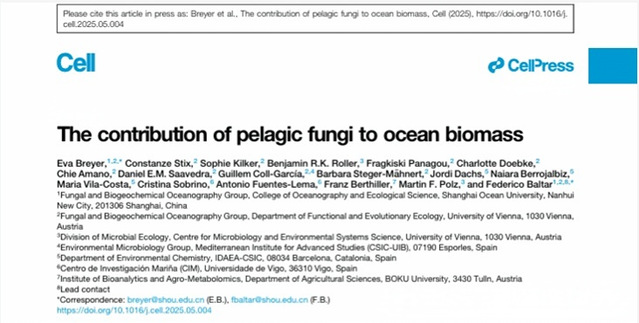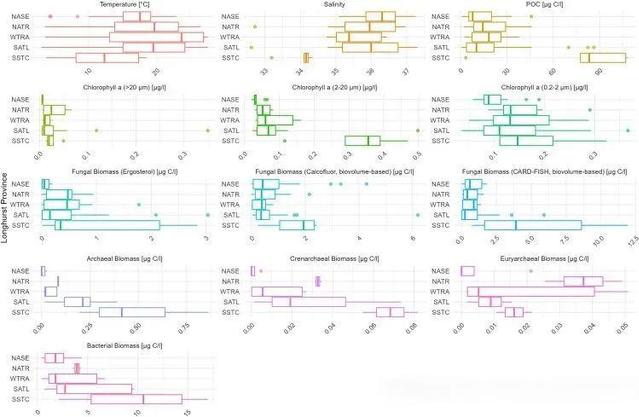发布日期:2025-05-24本条信息已被查看了10次
Cell | Shanghai Ocean University & University of Vienna - Federico Baltar's Team: Redefining the Contribution of Planktonic Fungi to Ocean Biomass! For a long time, planktonic bacteria and archaea have been considered the primary drivers of microbia
For a long time, planktonic bacteria and archaea have been considered the primary drivers of microbial carbon cycling in the vast oceans, while planktonic fungi have remained almost invisible in this narrative. However, on May 23, 2025, a groundbreaking study led by first and corresponding author Dr. Eva Breyer from Shanghai Ocean University & University of Vienna, and corresponding author Professor Federico Baltar, was published in Cell: The Contribution of Pelagic Fungi to Ocean Biomass. This research marks the first systematic and precise quantification of planktonic fungal biomass across the global oceans, challenging traditional understandings of microbial carbon stocks in the marine environment.
在浩瀚的海洋中,浮游细菌和古菌长期被认为是主导微生物碳循环的主角,而浮游真菌的存在感几乎为零。然而,2025年5月23日,由上海海洋大学&维也纳大学第一作者兼通讯作者Eva Breyer 博士和通讯作者Federico Baltar 教授主导发表于Cell的研究:The contribution of pelagic fungi to ocean biomass,首次对全球大洋中浮游真菌的生物量进行了系统而精确的定量,挑战了我们对海洋微生物碳库存的传统认知。

Baltar’s team conducted an unprecedented large-scale sampling effort along a transect spanning 11,000 kilometers across the Atlantic Ocean, covering five typical marine ecological zones from 40°N to 50°S latitude. The study employed a trio of complementary techniques: extraction of the fungal-specific sterol ergosterol, Calcofluor White (CFW) fluorescent staining, and CARD-FISH hybridization targeting fungal rRNA. These were paired with microfluidic mass sensors to measure fungal cell dry weight, thereby constructing a comprehensive conversion system for estimating fungal carbon in the ocean.
Federico Baltar团队利用横跨整个大西洋、长达11000公里的采样航线,覆盖从北纬40°到南纬50°的五个典型海洋生态区,开展了前所未有的大规模浮游真菌采样与定量工作。研究方法整合了三种互补技术:真菌特有的膜类物质麦角固醇(ergosterol)提取、荧光染料Calcofluor-White染色(CFW)和靶向rRNA的CARD-FISH探针杂交技术,辅以微流控质量传感器测定真菌细胞干重,从而构建了一整套适用于海洋真菌的碳转化因子体系。
This integrated methodology not only addressed the high uncertainty associated with prior fungal biomass estimates based largely on gene copy numbers, but also significantly narrowed the global estimate range—from a two-order-of-magnitude gap to less than one. The final estimate from the study puts global pelagic fungal carbon storage at 0.32 Gt C (with a confidence interval of 0.19–0.46 Gt C). This is not only far higher than previous indirect estimates, but also clearly demonstrates that fungal biomass is nine times that of archaea, second only to bacteria. The biomass ratio among fungi, archaea, and bacteria is estimated as 1:9:44.
这一组合方法不仅填补了以往对真菌生物量估算过度依赖基因拷贝数的不确定性,还显著缩小了全球真菌碳库存的不确定范围,从之前的两个数量级降低到不到一个数量级。研究最终估算出,全球海洋中浮游真菌的碳储量高达0.32 Gt C(置信区间为0.19–0.46 Gt C),不仅远高于以往间接估算值,也首次明确指出其生物量是古菌的9 倍,仅次于细菌,三者的生物量比例为1:9:44。
The study also found that planktonic fungi are closely correlated with chlorophyll concentration, suggesting a critical role in the degradation of particulate organic carbon (POC) derived from phytoplankton. Particularly in high-primary-productivity regions of the South Atlantic, fungal biomass was significantly elevated, implying a scavenger role in the recycling of organic material following phytoplankton demise. Remarkably, fungal presence was also clearly detected as deep as 2000 meters in the ocean's dark zones, indicating their broad involvement in carbon cycling throughout the entire water column.
研究发现浮游真菌与叶绿素浓度密切相关,显示它们在降解浮游植物所形成的颗粒有机碳(POC)中扮演关键角色。特别是在南大西洋高初级生产力区域,真菌生物量显著升高,表明其可能在浮游植物凋亡后的有机质再循环中发挥“清道夫”功能。此外,即使在2000米深的暗黑海域,真菌的存在也被清晰记录,显示出其对整个海洋水柱碳循环的广泛参与。
Technically, this study establishes a replicable standard for quantifying marine fungi. Theoretically, it proposes a revolutionary perspective: planktonic fungi should be considered the third pole of the ocean carbon cycle, necessitating their formal inclusion in global biogeochemical models. As marine ecosystems face increasing pressures from global environmental change, revisiting these previously overlooked microbial players not only fills critical knowledge gaps but also lays the foundation for more accurate carbon cycle models.
本研究不仅在技术层面上建立了可复制的真菌定量标准,在理论层面更是提出了一个颠覆性的观点:浮游真菌应被视为“海洋碳循环的第三极”,其在全球碳预算中的角色应被重新估量,并正式纳入生物地球化学模型之中。在海洋生态系统面临全球变化压力的当下,重新审视那些被忽视的微生物成员不仅有助于填补知识空白,更是构建更准确碳循环模型的基石。Breyer与Baltar 团队的工作,为此迈出了关键的一步。



Reference
Breyer E, et al. The contribution of pelagic fungi to ocean biomass. Cell. 10.1016/j.cell.2025.05.004